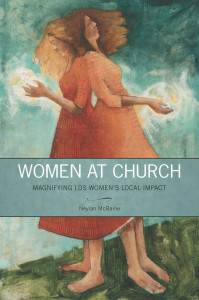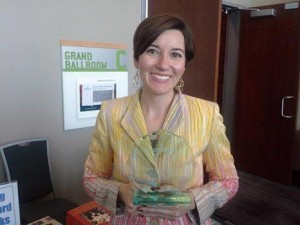Neylan McBaine is one of several notable and thoughtful participants in the conversation that has been taking place about the roles and situation of women in The Church of Jesus Christ of Latter-day Saints. Her soon-to-be-released book, Women at Church: Magnifying LDS Women’s Local Impact, is both a tremendous synopsis of that conversation for those who are still trying to get a handle on its many facets and a valuable and constructive contribution in its own right. Sister McBaine is the founder of the Mormon Women Project, which collects stories of LDS women for the purpose of celebrating and highlighting their lives, accomplishments, and contributions, a worthy goal in a church that celebrates that which is of good report and praiseworthy, but also a worthy goal for one interested in better understanding the human condition.
Her book draws upon a wide variety of sources. I saw mention of most of the major discussants, a host of more minor ones, and many individual women and men who shared their experiences navigating the labyrinth of gender relations in the relative privacy of their own lives. Apart from merely having a large pool of sources from which to draw experience and wisdom, this book also accomplishes a measure of balance. The author explains both sides of many of the issues in LDS gender relations in terms proponents of each position will likely relate to. Thus people with a variety of opinions will be both informed and challenged by this book. The author also presents some challenging perspectives. Not all of her anecdotes end well. But this also plays the important role of highlighting the real human lives and souls that are at stake in the effort to live our religion in a truly thoughtful, inclusive, and Christ-like manner. Though the book contains a number of stories that are necessarily sorrowful, the book maintains a genuinely hopeful tone of focused optimism. This is not a book that should leave people depressed or hopeless, but instead give them perspective and ideas for how to improve.
For me personally, this book succeeded in accomplishing several important things. It helped me understand some of the more common or characteristic sources of frustration. It convinced me that having sisters more visible is important for spiritual reasons beyond any worldly arguments that may exist for it. And it helped reinforce my confidence that our leaders are working to improve these situations, and that there is significant scope for us to work for better relationships within the scope of our own stakes, wards, and branches.
Why is it important for women (or any sort of person, really) to be visible to others? In reading this book, a few reasons become apparent. One that the author brings up is that the process of creation necessarily involves models. When God created the earth, those creations were “spiritually, before they were naturally upon the face of the earth.” And it makes sense for us to desire models to use to form our own worlds as well. Jesus, who also famously counseled that we should do our alms in secret, commanded the disciples to “let your light so shine before this people, that they may see your good works and glorify your Father who is in heaven” (3 Nephi 12:16). While on the surface these two directives appear to be at variance, the principle appears to be that we are not rewarded of God for self-aggrandizement and seeking the praise of the world, but we nevertheless help to glorify God when our example teaches others how to succeed in living in accordance with His plan. Not every woman’s path will look the same, and it is important to have women who represent the variety of possible righteous lives visible so that others seeking to find a righteous example upon which to pattern a faithful life in their own circumstances can have the undergirding benefit of an example. The life of faith is one of challenges, but challenges that need not be encountered alone and without a map.
Turning attention to some of the means the author proposes for providing female role models, one of the most encouraging points she brings up is the fact that many of the practices that could be adopted to provide visibility to women on a local scale are already being modeled by our general leaders. She notes the recent deliberate inclusion of women auxiliary leaders in prominent positions in the seating arrangements for General Conference, as well as their inclusion in the Conference Ensign center sheets showing general leaders. Of particular interest in this last conference is a talk by Linda S. Reeves dealing with protecting the home from pornography. This talk sets a strong example of a general leader speaking to the whole church, just as one giving a talk in sacrament meeting (who likely holds some particular stewardship in the ward) speaks by default to the whole group rather than only those who they are assigned to serve in some particular capacity. This was further driven home by her choosing to address what has traditionally been thought of as a male problem, though participation by either gender is thoroughly unfortunate.
This idea of leaders speaking to the needs of the whole church rather than just one particular subset of it is further amplified in the council setting. In a ward council, the sisters who preside over the auxiliary organizations are asked to share their insights and inspiration on all matters that come before the council. The inspiration of these sister leaders is then able to benefit the entire ward body. When all functions properly, input from sisters functions on an equal footing with input from the brothers in the ward. This practice has likewise been modeled at the general level. Sister Eubank’s recent FairMormon talk included her recounting of her experiences with councils that made sure they heard and understood her insights before proceeding. Properly conducted ward councils have received strong encouragement from Elder Ballard, who has been counseling leaders to properly harness the full potential of their Ward Councils for 20 years. The more these councils fulfill their full potential, the more our sisters are able to fulfill theirs.
Neylan McBaine also discusses the great latitude that local leaders have to solve problems of visibility and recognition on the local level. She emphasizes the importance of spiritual creativity by leaders in the process. She discusses a number of approaches that have been taken with baby blessings to make sure the mother was recognized, while still keeping within the bounds of church policies. One of several discussed was inviting the mother to sit on the stand at the meeting where the blessing occurred so that she had a good view of the ordinance and so that she could be seen and receive the recognition of the congregation. A number of other good approaches were discussed. The key really does seem to be in spiritual creativity, and a willingness to explore ways to include and recognize the real and significant contributions and accomplishments of women. There is enough space within the church policies for these things to happen, if people are willing to experiment a bit, be patient with one another, and withhold judgment.
Another area where she identified possibilities for women to contribute is the sacrament. Apparently, (something I was less aware of before reading this book) women have historically provided bread for the sacrament, and any way you look at it, purchasing Wonder Bread is an assignment not strictly necessitating priesthood authority. Reading the beautiful account of a sister who prepared the sacramental bread, I couldn’t help recalling that the bread represented the flesh of the savior, and that, indeed, that flesh was molded and formed and prepared by a woman. Inviting then the Lord’s handmaids to provide the bread might even enhance the meaning of the ordinance and at the same time highlight one of the most uniquely key and feminine contributions to the salvific history of the human family.
The insights shared in this review are a very small sampling of what one person got out of a remarkably thoughtful book. Anyone that would like to get up to date on the conversation about women in the Church of Jesus Christ should locate a copy of it immediately. I’d loan you mine (with a deposit), but I am but one man with but one copy. If you’d like, though, this is important enough of a book that we have them available for preorder at the FairMormon bookstore at a bit of a discount. The author was kind enough to personalize my copy while I was at the FairMormon Conference, where she received the FairMormon Award of Excellence. She wrote, “With hope in the future.” This book gives me a lot of reasons for hope.


